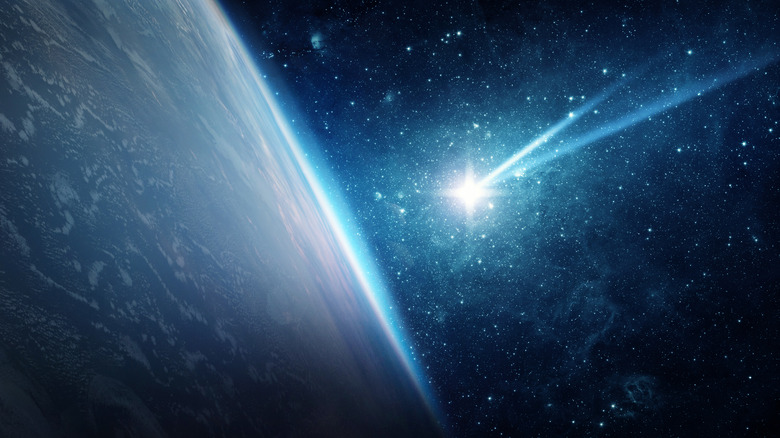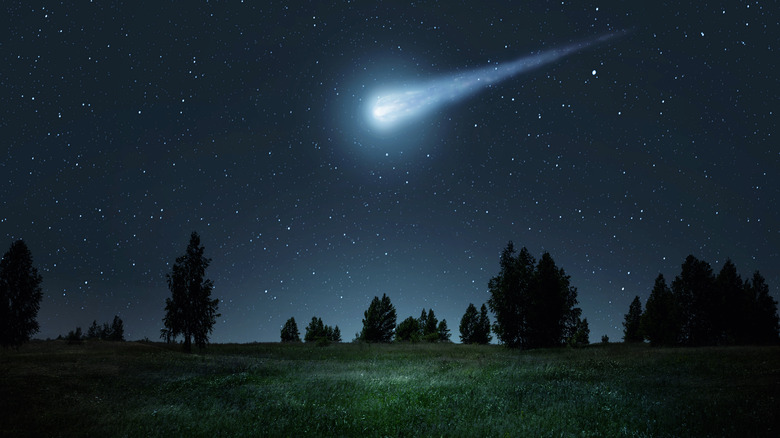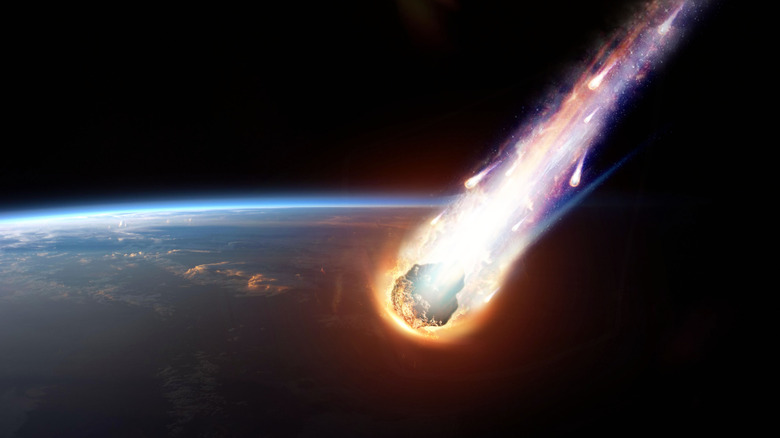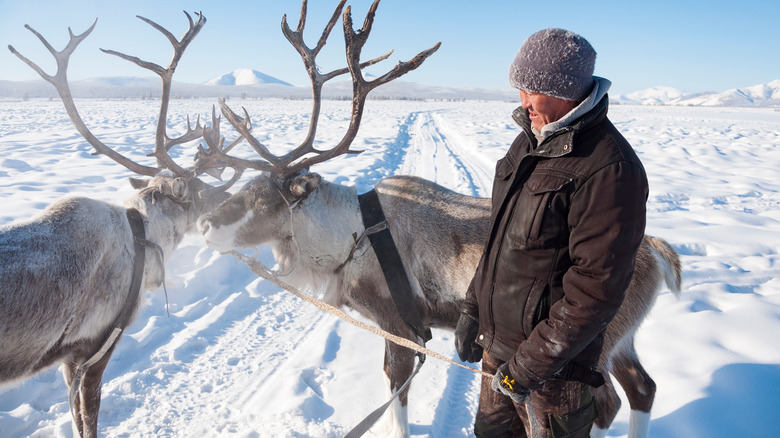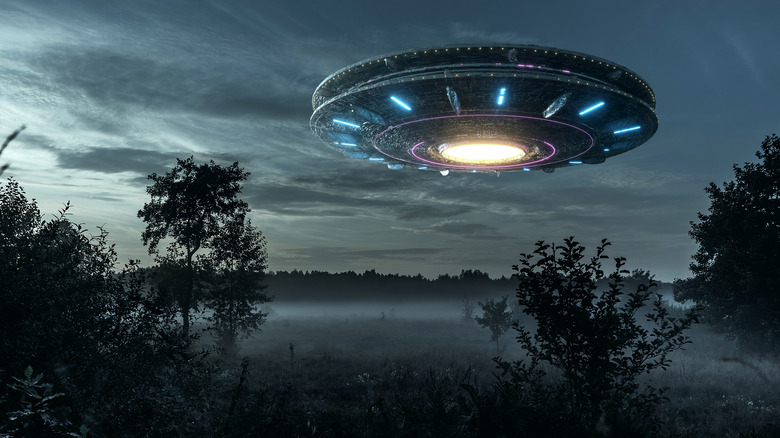The Biggest Theories About The Tunguska Event: What Really Happened?
Early in the morning of June 30, 1908, according to Britannica, an explosion occurred over the skies of Russia's Siberia region. Specifically, the blast, estimated to be in the range of 15 megatons — 1,000 times more powerful than that of the atomic bomb dropped on Hiroshima — occurred somewhere near the Podkamennaya Tunguska River, and is believed to have leveled hundreds of thousands of acres of trees, with the heat from the blast charring another 38 square miles of forest. Fortunately, the event took place in a remote region near the Arctic, and as such, the number of people to have been injured and/or killed in the event is mercifully low: likely no more than three deaths, according to ScienceDirect, and an unknown number of injuries, although the total number of people believed to have been in the blast zone at all is less than a few dozen. Had the event taken place over a populated area, such as Metro London, the death toll could easily have been in the millions.
The Tunguska Event, as its called, serves as a reminder of just how vulnerable the Earth and its inhabitants are to the random bits of space detritus that are zinging about through the solar system and, like the K-T asteroid that wiped out the dinosaurs, could destroy humanity. However, scientists are still trying to figure out what, exactly, it was that occurred over Tunguska that day.
Did a comet explode over Tunguska?
Scientists attempting to figure out what happened at Tunguska have found themselves bedeviled by two major problems. First, the event happened a century ago, meaning that there are no surviving eyewitnesses and little to nothing in the way of physical evidence. Further, the site of the event is so remote that even getting to it is a major undertaking. Once at the site of the event, however, scientists have been met by more questions than answers. As Forbes notes, there is no impact crater, and researchers have been unable to find any meteorite fragments or any other evidence of an object striking the Earth.
That's exactly why, for decades, a leading theory was that the event was caused by a comet that didn't strike the planet, but instead exploded in the atmosphere above. Comets are largely made of ice and interplanetary dust, and ice melts at temperatures well below the searing temperatures that would be achieved via friction as the bit of space debris hurled through the atmosphere.
Or was it a meteor?
A cousin to the comet is the asteroid, another bit of space debris that moves hither and yon across the universe, and woe betide any planet that happens to be in one's path. Unlike comets, meteors are made not of ice, but of solid rock and metal. Fortunately, as Irish News explains, the Earth's atmosphere does a good job of causing most of them to burn up, or skip off like a rock skips across a lake, before they do any damage. However, asteroids sometimes make their way through — just ask the dinosaurs or, more recently, the people of Chelyabinsk, the site of one of the most dramatic meteor events in recent memory (per NASA).
As Forbes reports, in 2020 Russian scientists postulated that it wasn't a comet that exploded over Tunguska that day, but a meteor. The science is complicated, but in essence the researchers, using simulations and eyewitness accounts, concluded that the event could have been caused by a meteor, likely 160 to 650 feet across and moving at 43,000 miles per hour, vaporized completely in the upper atmosphere, leaving no physical traces or impact crater, while still managing to level tens of millions of trees.
Or was it the wrath of a vengeful tribal god?
Eyewitness accounts of the Tunguska Event are few and far between, due to the fact that the area was (and is) sparsely populated. What's more, the event happened over a century ago, and what eyewitness accounts remain are based on secondhand oral tradition, according to Forbes.
One such account, via History Rundown, comes from an Evenki tribeswoman named Akulina who, if her account is to be believed, was within about 20 miles of Ground Zero when the event took place. Akulina is clear that the source of the explosion was entirely supernatural and, specifically, due to Agda, the God of Thunder, one of her tribe's gods.
"A mighty wind flattened our tent, while we had been sleeping. A brilliant outburst of light blinded us, the wind was breaking trees like they were sticks. As a rising whirlwind lifted us off the ground, I lost consciousness ... Our reindeers also vanished, and we haven't found them since," she said.
It bears noting that Akulina's account isn't presented here to be taken seriously, although the Evenki certainly did: The tribe deemed the site sacred immediately after the event and reportedly harassed and even killed Soviet scientists who showed up to study the site.
Or did an alien spacecraft malfunction?
Moving further into the realm of the ridiculous, another "out there" explanation of the Tunguska Event, via History Rundown, comes from Russian author Alexander Kazancev. He visited Hiroshima — the site of the first atomic bomb used in warfare — and noticed that some of the trees that were left standing in the city had their branches and leaves removed, via the force of the explosion. He noticed the same thing around the site of the Tunguska explosion, and concluded that both were caused by nuclear explosions. Further, burn patterns around the trees in both locations showed that they were burned more strongly on one side than the other, also evidence that the writer took as suggesting a nuclear origin.
The problem is that, as a weapon of war, nuclear energy wouldn't appear on the scene until decades after the Tunguska event. Kazancev concluded that the explosion was caused by extraterrestrials using a nuclear engine in their spacecraft — a craft which experienced some sort of malfunction over Siberia and exploded.
Or did Nicola Tesla almost destroy the world with a death ray?
It goes without saying that some of Nicola Tesla's ideas were ahead of his time. Put slightly less charitably, some of his ideas were implausible, foolhardy, and/or downright dangerous, as Smithsonian Magazine notes.
One of Tesla's projects was to be a defensive weapon that would transmit energy wirelessly and would, if everything worked out properly, neutralize incoming attacks, such as missiles, from hundreds of miles away. That's all well and good, reports New Scientist, except that one of Tesla's tests of the "Death Ray" happens to have coincided with the time of the Tunguska explosion. Further, Tesla purportedly aimed his contraption towards the North Pole and told explorer Robert Peary, who was headed in that direction, about his plans.
After hearing about the explosion, Tesla reportedly concluded that his weapon was responsible and quickly dismantled it. He also reportedly never heard back from Peary, particularly about any reports of anything noteworthy happening in the Arctic that day.
